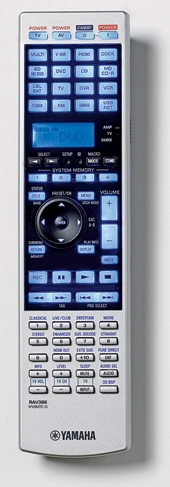Yamaha RX-V3900 A/V receiver Page 2
 |
On the video side, the V3900 implements rather complete video processing, courtesy of VRS silicon from Anchor Bay (DVDO). It can process video coming over both analog and HDMI inputs, deinterlacing and scaling as required up to 1080p resolution. The V3900's processing performed very well on our battery of video test patterns, showing excellent resolution and deinterlacing for both film- and video-sourced material.
One feature I encountered here for the first time, HDMI-Through, can route HDMI signals to either output when the receiver is in Standby. You can also set it to route the last-used source, or to lock onto a particular one regardless of which source was last selected. This could be wonderfully useful for quick, "catch the news" TV viewing from a cable or satellite tuner, for example, or for a two-screen setup where you use a front-projector system for serious home theater viewing and a smaller LCD screen for the daytime.
ERGONOMICS
Yamaha's new onscreen display system is the best A/V receiver interface I've seen yet. It pops up (and down) instantly, is clear and attractive, and strikes the right balance between hierarchical menu depth and simplicity. It's also stacked with nifty, well-implemented features, including handy submenus, a one-touch Info page that shows input- and output-signal formats and bit rates for both audio and video, and bookmarking to take you straight back to the last screen visited.
The V3900's networking elves found my wired home network without prodding, and handily served up files in MP3, AAC, and WAV formats from the public-domain DLNA media server I run on my Mac. There's also a very complete iPod implementation (with an optional Yamaha dock) that exploits the onscreen interface. Less happily, browsing content from networked sources is limited to scrolling through potentially very long lists of track, artist, or album. There's no search function, although you can memorize eight favorite items (directories/play-lists, files, or net-radio streams) for one-key recall and also shuffle lists, which helps a little. There's also no compatibility with public-domain format FLAC (bummer!) or pro-standard AIFF files.
Yamaha's supplied remote control is another keeper. Its generous key lighting is almost too bright, and its layout, while dense, is sensible and includes HDMI output switching, one-key access to such important functions as channel-level tweaks, and direct access to the major surround modes. Plus, Yamaha supplies a second, simplified mini remote for day-to-day operation.
I did encounter one recurring glitch. When interrupting an HDMI data stream, such as when skipping chapters on a Blu-ray Disc or DVD or when changing cable-TV channels, the Yamaha frequently failed to immediately unmute the audio, with the delay ranging from a second or two to as long as 20 seconds. But hitting the volume key (or the Mute button twice) always brought the sound back directly.
BOTTOM LINE
Yamaha's RX-V3900 is all about features - and I've hit far from all of them here. More importantly, almost all of them are well conceived and potentially useful while taking advantage of the design's winning ergonomics. Best of all, the Yamaha's fundamental audio and video performance is more than solid, and while not exactly cheap, the RX-V3900 costs thousands less than the most expensive receivers - including Yamaha's own. Short version: I liked it a lot.








































